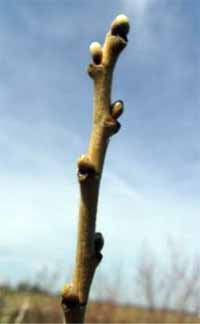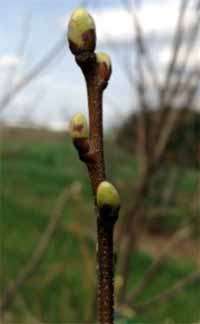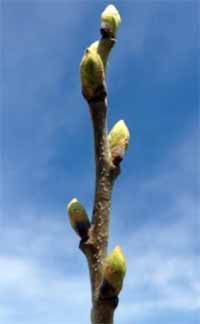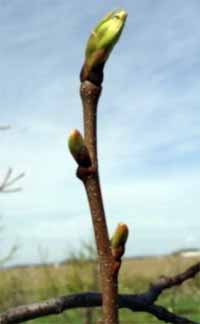Michigan chestnut update – May 8, 2013
Chestnut trees are breaking dormancy at locations around Michigan. MSU Extension will be tracking chestnut development this season and providing growers with relevant pest management information.
As the weather warms, chestnuts are showing signs of breaking dormancy with green tissue visible in central and southern Michigan and bud swell/bud break in northwest Michigan. There is significant variability in growth stage across the state and differences in development are also significant between different cultivars and species. The variability in development stages is reflected in growing degree day (GDD) accumulation differences across the state with the Leslie Enviro-weather station recording 184 GDD 50, Clarksville at 149 GDD 50 and the Northwest Michigan Horticultural Research Center at just 110 GDD 50 as of May 6.




Left to right: Photos 1 and 2 show ‘Benton Harbor’ (Chinese chestnut cultivar) and ‘Colossal’ (European/Japanese hybrid) at bud break. Photos 3 and 4 are ‘Labor Day’ (Korean chestnut cultivar) and ‘Okei’ (European chestnut cultivar) at green tip. Remember, even though we are showing the growth stages of Chinese chestnut cultivars and European/Japanese hybrids, these two groups should not be grown together due to internal kernel breakdown that causes a rot-like issue in the nuts when these cultivars cross-pollinate. Visit chestnuts.msu.edu for more information on proper interplanting to avoid internal kernel breakdown. Photo credits: Mario Mandujano.
Dormant oil applications for mite management should be wrapping up and many growers will be making the first fertilizer applications of the season if they haven’t already. As temperatures warm and thunderstorms become common, growers should be placing yellow sticky traps in orchards to track the arrival of potato leafhoppers. Like many plants, chestnuts are sensitive to the saliva of potato leafhoppers that is injected by the insect while feeding. Damage to leaf tissue can cause reduced photosynthesis that can impact production and quality, and damage the tree.
Most injury occurs on new tissue on shoot terminals with potato leafhopper feeding near the edges of the leaves using piercing-sucking mouthparts. Symptoms of feeding appear as whitish dots arranged in triangular shapes near the edges. Heavily damaged leaves are cupped with necrotic and chlorotic edges and eventually abscise from the tree. Severely infested shoots produce small, bunched leaves with reduced photosynthetic capacity.
Adult leafhoppers are pale to bright green and about 0.125 inches long. Adults are easily noticeable, jumping, flying or running when agitated. The nymphs (immature leafhoppers) are pale green and have no wings, but are very similar in form to the adults. Potato leafhoppers move in all directions when disturbed, unlike some leafhoppers which have a distinct pattern of movement.
Potato leafhoppers can’t survive Michigan’s winter and survive in the Gulf States until adults migrate north in the spring on storm systems. Watch for a future Michigan State University Extension articles on potato leafhopper management recommendations and more scouting tips, or visit www.chestnuts.msu.edu.



 Print
Print Email
Email


